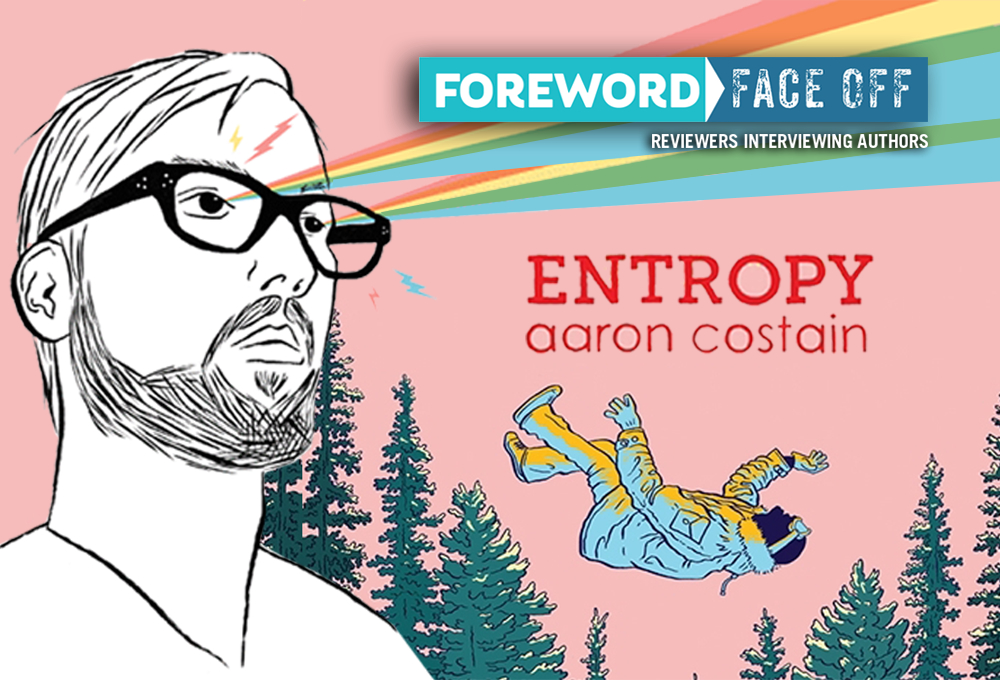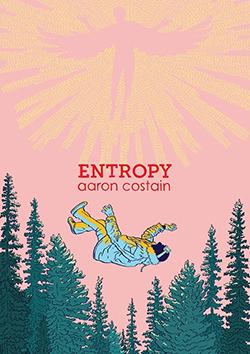Reviewer Peter Dabbene Interviews Graphic Novelist Aaron Costain, Author of Entropy

Over recent years, the editorial team at Foreword Reviews has developed deep affection for graphic novels, mainly because longtime reviewer Peter Dabbene has opened our eyes to the intricacy and skill of the best artists/writers working in the genre. Peter’s sharp observations and writing chops compelled us to create a recurring Graphic Novel Spotlight feature in every issue of the magazine, and reader surveys confirm it’s hugely popular.

For a recent special interest publication on religion, Managing Editor Michelle Anne Schingler assigned Peter to review Entropy-–a new project by Aaron Costain and publisher Secret Acres—and his glittering critique made it clear we had the right-perfect formula for a Face Off interview between two graphic novel experts.
What’s the significance of the title Entropy?
In the context of this book, Entropy is the gradual decay of systems over time—a slow slide into disorder, or perhaps the return of a natural equilibrium. The world of this book has undergone some kind of cataclysm, perhaps a great flood, and the remnants of the human world are slowly rotting and falling away.
Entropy is something of a big melting pot of mythological and religious allusions and influences. Can you name a few of your main influences, both for Entropy specifically, and as an author and artist overall?
One of the biggest influences on this book is Carlo Collodi’s strange take on the Golem tale, Pinocchio. It is so much weirder and more disturbing than the Disney version everyone knows. I am also an avid Haruki Murakami reader, and his esoteric mystery books (Hard Boiled Wonderland and the End of the World, or Kafka on the Shore) also informed Entropy. I love that there are no easy answers spelled out for you in those novels. Andrei Tarkovsky’s brilliant film Stalker is another clear antecedent to Entropy; there is plenty of walking and talking and philosophizing in a devastated landscape.
Not long after I started this book, I discovered Anders Nilsen’s minicomic series Big Questions. He was exploring similar themes to Entropy, so I began to follow him closely. Artistically, I owe so much to Jaime Hernandez of Love and Rockets fame. His beautiful lines and spot blacks are everything I want out of my art. It is interesting to me to look at his early work, which has a ton of hatching and mark making, and see his evolution as he slowly strips back the amount of lines on a page until he reaches his current minimal style. You can see a similar transition in Entropy from beginning to end, though I don’t pretend to be on the same level as Jaime. I also really appreciate David B, a French cartoonist who uses symbols in his work in a way that can only be done in comics. There are a few moments in Entropy where I have done the same thing—trying to convey an idea through an abstracted image instead of a literal one.
You attended art school, dropped out, and later became an architect. What drove those decisions? Was there something you were looking for and not finding?
I think that what I wanted from art school was a focus on improving my existing art skills, but instead what I got was a focus on theory and being able to talk about the art. I couldn’t stand the post-rationalization and pretentiousness, so I dropped out and switched to art history. It was the best decision I had ever made—the History in Art program at the University of Victoria is very much not Eurocentric, and it exposed me to a broad range of art from around the world. It allowed me to see how various cultures influenced each other and cross-pollinated, which was really the foundation for this book.
While I was doing my degree I realized that most of my papers ended up focusing on buildings, so once I graduated I moved to the other side of the country to study architecture. Architecture school has a similar studio/crit system to art school, but somehow it didn’t bother me this time, perhaps because architecture has certain technical and programmatic requirements that naturally cut down the bullshit.
How does your architecture training translate to pictorial storytelling? Is there something in particular that you enjoy about cartooning in contrast with architecture? For example, is it fun just to be able to draw structures that don’t necessarily need to adhere to building codes, or do you delight in drawing animals and other completely non-architectural stuff?
Entropy really doesn’t have many buildings in it. The ones that are there are completely designed, even parts that we don’t see in the book. I just couldn’t help myself. But most of the time, it’s an exercise in drawing organic things—people, animals, trees and more. My drawing process has changed over time, going from using leftover pens from architecture school (which lend themselves to hard edges) to exclusively drawing with Japanese G-nib dip pens. I find that the dip pens encourage drawing in a flowing manner, but with a little more control than a brush.
But the real delight of drawing comics is the amount of control I have. Architecture is very much a collaborative field, from the team who designs the building to the contractors who execute them. My comics, on the other hand, are 100 percent mine. I have complete control over every aspect of the book—the writing, the drawing, and even the book design. It’s like making a movie entirely by yourself.
Entropy is the kind of book that requires a reader to stop every so often and digest what’s been taken in, rather than just zip through it. How much of Entropy is intended to have a single, direct interpretation, versus each reader interpreting the story differently?
That is really the point of the book. Everyone will have their own interpretation of the events within, in much the same way everyone has their own interpretation of religion. It doesn’t matter whether the reader knows the specific references I am making; it is up to them to interpret what is on the page and make up their own minds. I wish everyone would think more critically and not just follow what others tell them to think, be it politics, religion, or the online hordes. Entropy is about the impossibility of knowing the divine, and not blindly trusting what you are told to believe.
In a 2009 interview, you mentioned starting a project that would bring methods of reading architectural drawings into comics, and said that you were “trying to adapt the architectural sequence of drawings into a narrative structure in a way that Chris Ware and John Pham have not already tried.” How did that project turn out, and will we be able to see the results?
That never panned out. It turned out it was too much of a formalist exercise for me. I appreciate formalist comics, but I don’t think that I’m really the one to make them. The being said, in 2010 I did end up writing an essay on the subject for The Hooded Utilitarian about reading architectural drawings and comics, and the similarities and differences between the two. I think I got out all my thinking on the subject in that essay; I doubt we’ll see a comic in that vein.
What are you working on now, and what’s ahead?
I am planning to go back to self-contained stories for the immediate future. Entropy has been such a long undertaking that I want to focus on producing discreet single-issue comics for a while. I had some fun doing an Edwardian-style ghost story excerpt for Canadian Notes and Queries a few years back, and I’ve been thinking about doing some horror work for a change. All that being said, if inspiration strikes, I’ll dive back into another graphic novel!
Peter Dabbene
